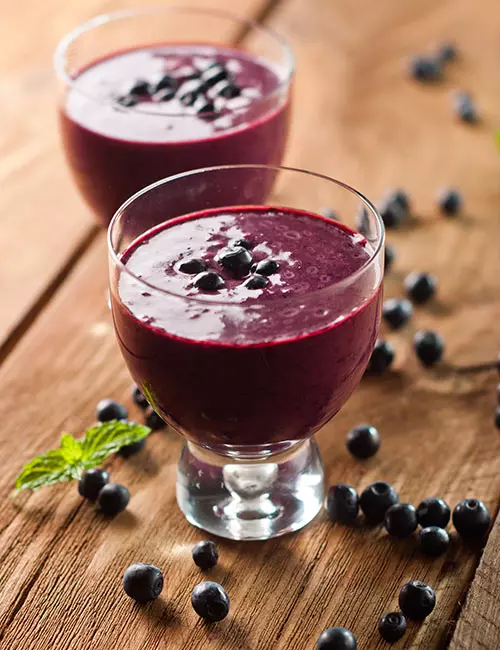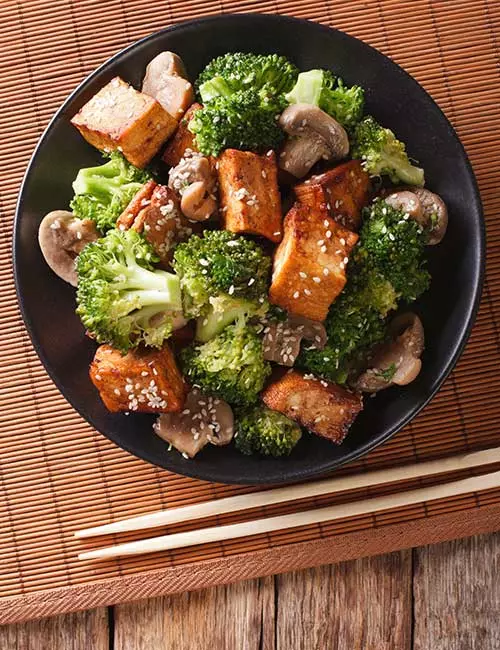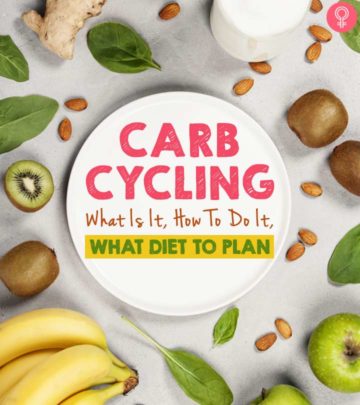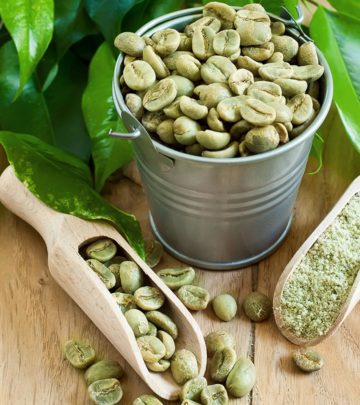Pegan Diet: What Is It And How Does It Work

Image: Shutterstock
The Pegan Diet is the newest healthy eating trend that everyone is raving about. This unique diet was created by Dr. Mark Hyman, M.D., and it combines the best of both Paleo and vegan diets.
According to Dr. Mark Hyman, focusing on non-starchy vegetables, fruits, and plant-based protein improves overall health, reduces body weight and inflammation, and improves glycemic control.
This article gives a detailed review of the Pegan diet, along with its benefits and potential downsides. Keep reading.
In This Article
What Is The Pegan Diet?
The Pegan Diet is a combination of Paleo and Vegan diets. It is a modified version of the Paleolithic diet that limits or excludes animal-based foods. It instead focuses on the intake of fruits and fresh vegetables, and plant-based protein, fats, and produce (1). The diet is formulated on the principle of eating nutrient-dense whole foods, whole grains, and limiting animal protein to prevent inflammation and improve overall health.
Studies have shown that eating more plant-based foods that are rich in fiber and phytonutrients with a low glycemic index can improve insulin resistance and body weight. Such foods can also control blood sugar levels (2).
The term ‘Pegan Diet’ was coined by Dr. Mark Hyman, who is the Director of the Cleveland Clinic Center for Functional Medicine, and author of The Blood Sugar Solution 10-Day Detox Cookbook. He came up with this concept in 2015. The Pegan diet is also called Dr. Hyman Diet (and the Pegan 365 diet).
How does the Pegan diet help control blood sugar levels, prevent weight gain, and maintain optimal health? We will explore the same in the following section.
How Does The Pegan Diet Work?
Studies show that eating five or more servings of fresh vegetables and fruits reduces inflammation, oxidative stress, and improves overall health (3). The Pegan diet follows the same principle, but with a little twist for sustainability. It fills 75% of your plate with fruits and vegetables, and the rest with lean cuts of animal protein. According to Hyman, “A good rule of thumb is to fill about 25 percent of your plate with a protein-rich foods — about the size of your palm.”
The diet helps balance all the nutrients and provides the essential amino acids and adequate fiber(4). It also emphasizes eating foods with a low glycemic index. As per studies, such foods are effective in lowering body weight and controlling blood sugar levels (5), (6).
The Pegan diet encourages the intake of healthy fats from fish, nuts, seeds, and other plant sources that are rich in unsaturated fatty acids. These may have a positive effect on heart health (7), (8),(9).
Furthermore, this diet also focuses on eating plant-based whole foods that improve overall health and consequently aid weight loss (10). The Pegan diet recommends grass-fed meat and wild-caught fish, as these are protein sources that are non-GMO and do not contain antibiotics or hormones. A study showed that the phytochemicals in grass-fed animals protect the meat from protein oxidation and lipid peroxidation. This could reduce the risk of inflammation (11).
In the following section, we have listed what foods you need to include in the Pegan diet.
What You Can Eat On The Pegan365 Diet
The Pegan diet strongly recommends whole grains, vegetables, and fruits, with a limit on processed foods and trans fats.
- Include Lots Of Plant Foods
Your plate should contain 75% of fruits and vegetables to add flavor and promote satiety. Include fruits and veggies with a low glycemic index that add bulk and regulate blood sugar levels (12). Include non-starchy vegetables like spinach, bamboo shoot, celery, cauliflower, carrots, broccoli, corn, eggplant, greens, etc. Include fruits like berries, apple, avocado, watermelon, and grapes.
- Choose Your Protein Wisely
Though the Pegan diet allows you to focus on plant-based foods, 25% of your diet should contain lean cuts of meat and seafood. Grass-fed pork, beef, and poultry should be emphasized. Choose low-mercury seafood options like Arctic char, Atlantic mackerel, rainbow trout, salmon, herring, and sardine. They are not only low on mercury but also contain high amounts of omega-3 fatty acids (13).
- Add Nuts And Seeds
Nuts and seeds add good-quality plant-based protein, fiber, and healthy fats to your diet. Studies show that including nuts and seeds in moderate amounts may help with weight loss and improve cardiovascular and metabolic profiles (14). Add a fistful of (15-20 g) nuts and seeds, including almonds, walnuts, pistachios, flax seeds, chia seeds, and pumpkin seeds to your diet. You may also consume them as snacks or sprinkle them on cereal porridges.
- Add Eggs
Eggs are aninexpensive source of high biological value protein. Though the vegan diet strictly omits eggs, the Pegan diet allows them. Eggs are not only high in protein but also other vital nutrients like phosphorus, iron, zinc, magnesium, and antioxidants that protect against degenerative diseases (15).
- Gluten-Free Whole Grains And Legumes
The Pegan diet discourages grains and legumes as they may elevate blood sugar levels. But a small amount of gluten-free whole grains and legumes can be included for satiety. Black rice, quinoa, amaranth, millets, steel-cut oats, lentils, chickpea, pinto beans, and black beans can be included in small amounts.
A study showed that gluten peptides might lead to insulin and leptin resistance, which are among the major causes of diabetes and obesity. A gluten-free diet may help prevent these conditions. However, more studies are warranted in this regard (16).
- Oils Rich In MUFA And PUFA
Cold-pressed olive oil and avocado oil contain heart-healthy MUFA (monounsaturated fatty acids) and PUFA (polyunsaturated fatty acids) (17). These oils can be included in moderation.
The Pegan diet is more flexible than a strict Paleo or a vegan diet. However, it also recommends you avoid certain foods.
Foods To Avoid On The Pegan 365 Diet
- All forms of dairy and dairy foods like cow milk, cheese, cottage cheese, yogurt, and curd
- All gluten-containing grains and whole grains
- Starchy legumes including peanuts, and all forms of lentils
- All forms of sugar and sugar products
- Processed foods
- Refined grains like white flour and corn starch
- Refined oils like that of sunflower, canola, corn, and soybean
- Food additives like colorants, flavoring agents, and preservatives
Let us go through a sample Pegan diet plan.
Dr. Mark Hyman’s Sample Diet Plan (For One Week)
Monday
| Meals | Foods To Include |
|---|---|
| Breakfast | Spinach omelet with a fistful of nuts and seeds |
| Lunch | Avocado salad with cherry tomato, asparagus, strawberry + pan-tossed salmon |
| Dinner | Vegetable soup + steamed broccoli |
Tuesday
| Meals | Foods To Include |
|---|---|
| Breakfast | Green smoothie with spinach, kale, coconut milk, apple, almond butter, and hemp seeds |
| Lunch | Creamy tomato soup+ 1 serving of quinoa bowl with chickpeas |
| Dinner | Smoked beetroot and tangerine with asparagus salad+ roasted flaxseeds |
Wednesday
| Meals | Foods To Include |
|---|---|
| Breakfast | Overnight oats with nut milk, chia seeds, and a bowl of berries |
| Lunch | Mango, avocado, shrimp salad+ sliced canteloupe |
| Dinner | Butternut squash soup+ Brussels sprouts salad |
Thursday
| Meals | Foods To Include |
|---|---|
| Breakfast | Chia seed apple pudding with crushed walnut+ bowl of berries |
| Lunch | Smoked chicken+ vegetable black rice pilaf |
| Dinner | Green peas soup+ baked sweet potato |
Friday
| Meals | Foods To Include |
|---|---|
| Breakfast | Protein smoothie made with berries, coconut butter, seeds, nuts, almond butter, and unsweetened almond milk |
| Lunch | Kale salad with pinto beans, avocado, and papaya |
| Dinner | Baked, wild-caught fish or pasture-raised lamb or organic chicken+ two tothree sides of vegetables, including dark green leafy vegetables, winter squash, and roasted mushrooms |
Saturday
| Meals | Foods To Include |
|---|---|
| Breakfast | Protein smoothie made with berries, coconut butter, seeds, nuts, almond butter, and unsweetened almond milk |
| Lunch | Kale salad with pinto beans, avocado, and papaya |
| Dinner | Baked, wild-caught fish or pasture-raised lamb or organic chicken+ two to three sides of vegetables, including dark green leafy vegetables, winter squash, and roasted mushrooms |
Sunday
| Meals | Foods To Include |
|---|---|
| Breakfast | Gluten-free toasted bread (sunny side-up) + bowl of fruit salad |
| Lunch | Barbeque potato salad+ buckwheat tabbouleh |
| Dinner | Olive oil tossed veggies with cashews/roasted almonds, onions, bell peppers, tomato, and black beans |
How Long You Should Follow ThePegan Diet
You may follow the Pegan diet as long as you can. You must make this diet your way of life if you intend to lose weight in a healthy way.
The Pegan diet is all about improving lifestyle habits that will not only help you lose weight but also improve your physical and mental health. In fact, you can follow the Pegan diet all 365 days of the year.
Here are a few recipes by Dr. Mark Hyman that will help you start the diet on the right note. Take a look!
Dr. Mark Hyman’s Recipes
1. Turmeric Shots
Ingredients
- 1 ½ cups unsweetened or fresh coconut water
- 2 tablespoons turmeric powder
- Juice of one lemon
- 1 tablespoon ground black pepper
How To Prepare
- Put all the ingredients in a shaker bottle and shake well.
- Pour the mixture into a shot glass and take your shot.
- Store the leftover mixture in the shaker bottle in the refrigerator. You may take 1-2 shots every day.
2. Berries And Cream Smoothie

Ingredients
- ½ cup frozen berries
- 1 cup spinach
- 1 cup vanilla almond milk
- 1 teaspoon ground flaxseed powder
- 1 tablespoon almond butter
- A pinch of cinnamon
How To Prepare
- Add all the ingredients to a blender and blend well.
- Pour the mixture into a glass and enjoy!
3. Skillet Tofu With Broccoli And Peppers

Ingredients
- 1 lb non-GMO tofu, drained and cut into cubes
- 1 large red bell pepper, chopped
- 10 broccoli florets
- 2 tablespoons sesame oil
- ½ inch ginger, grated
- ½ cup vegetable broth
- 2 tablespoons wheat-free tamari
- 1 tablespoon rice wine vinegar
- 2 tablespoons filtered water
- 1 tablespoon arrowroot
- 1 tablespoon white sesame seeds
- A handful of cilantro, roughly chopped
How To Prepare
- Heat the sesame oil in a pan.
- Add the broccoli, tofu, and bell peppers. Toss and cook for 2 minutes.
- Stir in the ginger and cook for 2 more minutes.
- Pour in the broth, tamari, and vinegar.
- Mix the arrowroot and two tablespoons of water in a small cup. Add the mixture to the pan.
- Simmer for 3 minutes.
- Give it a final stir.
- Switch off the burner.
- Garnish with sesame seeds and cilantro.
Let us scroll through the next section to understand the benefits of the Pegan diet.
Benefits Of The Pegan Diet
- A colorful plate is always appealing to your palate. Including plenty of fruits and 4-6 servings of non-starchy vegetables rich in fiber helps reduce the risk of weight gain (18).
- Plant-based foods loaded with vegetables have a low glycemic index. They stabilize blood sugar levels, reduce post-meal glucose spikes, and control body weight (19).
- The Pegan diet is less restrictive than the Paleo and vegan diets. It has the flexibility of eating animal-based proteins and gluten-free grains. This factor could make the diet sustainable in the long run.
Though the benefits are many, the Pegandiet also has certain downsides.
Downsides Of The Pegan Diet
- It can be too restrictive.
- Although it emphasizes on eating fruits and vegetables, grass-fed and pasture-raised meats are difficult to procure.
- Adding variety and arranging specific foods in the diet is time-consuming and expensive.
- Restricting to specific food groups may lead to nutrient deficiencies.
Is The Pegan Diet Right For You?
If you want to break your plateau and kick start your metabolism, the Pegan diet is right for you. But always consult your doctor and/or a registered dietitian prior. Take their guidance too in planning your diet, especially if you have any medical conditions.
Conclusion
There are hundreds of diets out there, and not all may suit you. The Pegan diet could be ideal for most, as it is well-balanced. It cuts out all the foods that cause inflammation and weight gain in a majority of the population. The diet is rich in nutrients, but not too restrictive like the Paleo or vegan diets. Consult your doctor and try the Pegan diet today. You may make it your lifestyle choice and reap benefits in the long run!
Frequently Asked Questions
Is the Pegan diet healthy?
Yes, the Pegan diet is healthy as it focuses on consuming plenty of fruits and vegetables that are loaded with vitamins, minerals, and fiber. It contains foods with a low glycemic index. These parameters are essential to keep you fit and healthy.
Can you drink coffee in the Pegan diet?
No, the Pegan diet does not allow the intake of such beverages.
Can you lose weight with the Pegan diet?
Yes, following thePegandiet can help you lose weight. It also can control your blood sugar levels and promote overall health.
References
Articles on thebridalbox are backed by verified information from peer-reviewed and academic research papers, reputed organizations, research institutions, and medical associations to ensure accuracy and relevance. Read our editorial policy to learn more.
- Gupta, Lovely et al. “Palaeolithic Diet in Diabesity and Endocrinopathies – A Vegan’s Perspective.” European endocrinology vol. 15,2 (2019): 77-82. doi:10.17925/EE.2019.15.2.77
https://www.ncbi.nlm.nih.gov/pmc/articles/PMC6785956/ - McMacken, Michelle, and Sapana Shah. “A plant-based diet for the prevention and treatment of type 2 diabetes.” Journal of geriatric cardiology : JGC vol. 14,5 (2017): 342-354. doi:10.11909/j.issn.1671-5411.2017.05.009
https://www.ncbi.nlm.nih.gov/pmc/articles/PMC5466941/ - Holt, Erica M et al. “Fruit and vegetable consumption and its relation to markers of inflammation and oxidative stress in adolescents.” Journal of the American Dietetic Association vol. 109,3 (2009): 414-21. doi:10.1016/j.jada.2008.11.036
https://www.ncbi.nlm.nih.gov/pmc/articles/PMC2676354/ - Gupta, Lovely et al. “Palaeolithic Diet in Diabesity and Endocrinopathies – A Vegan’s Perspective.” European endocrinology vol. 15,2 (2019): 77-82. doi:10.17925/EE.2019.15.2.77
https://www.ncbi.nlm.nih.gov/pmc/articles/PMC6785956/ - Zafar, M I et al. “Low glycaemic index diets as an intervention for obesity: a systematic review and meta-analysis.” Obesity reviews : an official journal of the International Association for the Study of Obesity vol. 20,2 (2019): 290-315. doi:10.1111/obr.12791
https://pubmed.ncbi.nlm.nih.gov/30460737/ - Thomas, D E, and E J Elliott. “The use of low-glycaemic index diets in diabetes control.” The British journal of nutrition vol. 104,6 (2010): 797-802. doi:10.1017/S0007114510001534
https://pubmed.ncbi.nlm.nih.gov/20420752/ - Schwalfenberg, Gerry. “Omega-3 fatty acids: their beneficial role in cardiovascular health.” Canadian family physician Medecin de famillecanadien vol. 52,6 (2006): 734-40.
https://www.ncbi.nlm.nih.gov/pmc/articles/PMC1780156/ - Swanson, Danielle et al. “Omega-3 fatty acids EPA and DHA: health benefits throughout life.” Advances in nutrition (Bethesda, Md.) vol. 3,1 (2012): 1-7. doi:10.3945/an.111.000893
https://pubmed.ncbi.nlm.nih.gov/22332096/ - Siriwardhana, Nalin et al. “Health benefits of n-3 polyunsaturated fatty acids: eicosapentaenoic acid and docosahexaenoic acid.” Advances in food and nutrition research vol. 65 (2012): 211-22. doi:10.1016/B978-0-12-416003-3.00013-5
https://pubmed.ncbi.nlm.nih.gov/22361189/ - Ha, Benjamin. “The Power of Plants: Is a Whole-Foods, Plant-Based Diet the Answer to Health, Health Care, and Physician Wellness?.” The Permanente journal vol. 23 (2019): 19-003. doi:10.7812/TPP/19.003
https://www.ncbi.nlm.nih.gov/pmc/articles/PMC6730944/ - Provenza, Frederick D et al. “Is Grassfed Meat and Dairy Better for Human and Environmental Health?.” Frontiers in nutrition vol. 6 26. 19 Mar. 2019, doi:10.3389/fnut.2019.00026
https://www.ncbi.nlm.nih.gov/pmc/articles/PMC6434678/ - Vega-López, Sonia et al. “Relevance of the Glycemic Index and Glycemic Load for Body Weight, Diabetes, and Cardiovascular Disease.” Nutrients vol. 10,10 1361. 22 Sep. 2018, doi:10.3390/nu10101361
https://www.ncbi.nlm.nih.gov/pmc/articles/PMC6213615/ - Abelsohn, Alan et al. “Healthy fish consumption and reduced mercury exposure: counseling women in their reproductive years.” Canadian family physician Medecin de famillecanadien vol. 57,1 (2011): 26-30.
https://www.ncbi.nlm.nih.gov/pmc/articles/PMC3024155/ - Ros, Emilio. “Health benefits of nut consumption.” Nutrients vol. 2,7 (2010): 652-82. doi:10.3390/nu2070652
https://www.ncbi.nlm.nih.gov/pmc/articles/PMC3257681/ - Miranda, Jose M et al. “Egg and egg-derived foods: effects on human health and use as functional foods.” Nutrients vol. 7,1 706-29. 20 Jan. 2015, doi:10.3390/nu7010706
https://www.ncbi.nlm.nih.gov/pmc/articles/PMC4303863/ - Haupt-Jorgensen, Martin et al. “Possible Prevention of Diabetes with a Gluten-Free Diet.” Nutrients vol. 10,11 1746. 13 Nov. 2018, doi:10.3390/nu10111746
https://www.ncbi.nlm.nih.gov/pmc/articles/PMC6266002/ - Orsavova, Jana et al. “Fatty Acids Composition of Vegetable Oils and Its Contribution to Dietary Energy Intake and Dependence of Cardiovascular Mortality on Dietary Intake of Fatty Acids.” International journal of molecular sciences vol. 16,6 12871-90. 5 Jun. 2015, doi:10.3390/ijms160612871
https://www.ncbi.nlm.nih.gov/pmc/articles/PMC4490476/ - Nour, Monica et al. “The Relationship between Vegetable Intake and Weight Outcomes: A Systematic Review of Cohort Studies.” Nutrients vol. 10,11 1626. 2 Nov. 2018, doi:10.3390/nu10111626
https://www.ncbi.nlm.nih.gov/pmc/articles/PMC6266069/ - Zafar, Mohammad Ishraq et al. “Low-glycemic index diets as an intervention for diabetes: a systematic review and meta-analysis.” The American journal of clinical nutrition vol. 110,4 (2019): 891-902. doi:10.1093/ajcn/nqz149
https://pubmed.ncbi.nlm.nih.gov/31374573/

Community Experiences
Join the conversation and become a part of our vibrant community! Share your stories, experiences, and insights to connect with like-minded individuals.
Read full bio of Merlin Annie Raj














